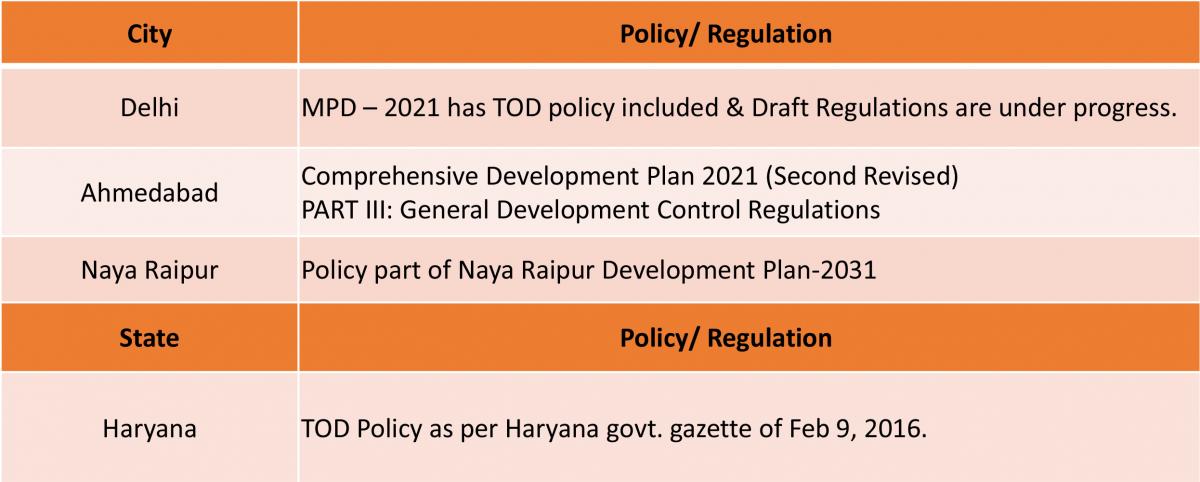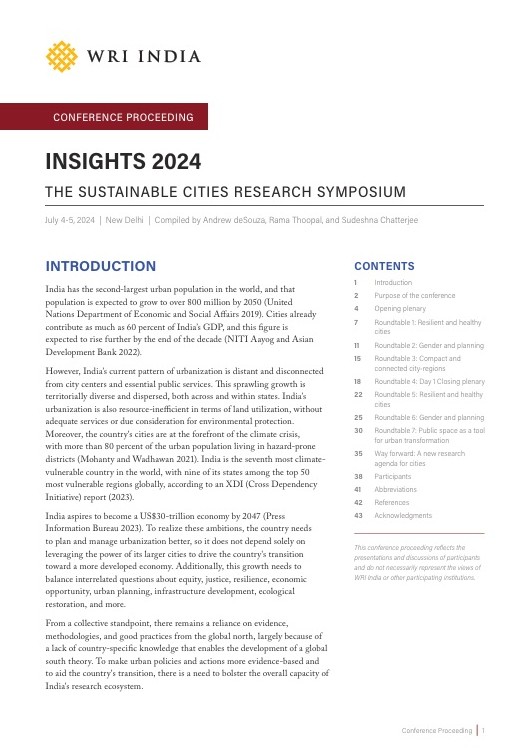Ratification of the National TOD Policy and its Implication for Indian Cities
by e -
The Ministry of Urban Development (MoUD) in May 2017 adopted the National Transit Oriented Development policy with the intention of providing a guiding document to states and cities that are adopting Transit Oriented Development (TOD) as an urban growth strategy. While Haryana, Delhi, Ahmedabad and Naya Raipur have TOD policies in place (refer to Table 1), states like Maharashtra and Madhya Pradesh, and cities like Mumbai, Bengaluru, Hyderabad, Hubli-Dharwad, and Kochi are looking to adopt TOD as the growth strategy and formulate TOD policies accordingly. TOD is a land development tool that integrates transit and land use, enabling sustainable practices with optimum utilisation of services, especially public transport. The concept encompasses and regulates the 6Ds viz., density, design, diversity, distance, destination and demand management.
The State of India’s Urbanization
The New Climate Economy (NCE) report, estimates that poor planning and urban sprawl could deter India’s growth, and the associated negative externalities may trigger financial losses amounting to 1.2 – 6.3% of the GDP annually. Factors like urban-rural migration, an economic shift towards secondary and tertiary sectors, availability of land at cheaper prices near the periphery etc. have led cities to grow horizontally.
Horizontal development has had consequences like increased trip lengths and higher usage of private vehicles, contributing to environmental degradation. Additionally, Municipalities are struggling to devise efficient collection and recovery mechanisms for the expansion of infrastructure services into peripheral areas of the city. According to the NCE report, the cost for providing infrastructure for sprawled, automobile-oriented development is likely to cost 10-30% more than in compact neighbourhoods. Thus, a mechanism to increase the density in specific zones is essential for better cities.
The World Bank projects that India will be among the countries leading the urban population surge by 2050. Further, McKinsey Global Institute's (MGI) 2010 report on India’s urban growth highlights that India could potentially save 6.2 million hectares of potentially arable land through effective land use planning by 2030. In such a scenario, it is important that we plan our cities carefully to meet the challenges & needs of this anticipated growth and the National TOD policy formulation seeks to contribute to the shift in city planning.
Following National TOD Policy Guidelines
Introducing the national TOD policy was critical towards realizing, supporting and bolstering the goal of creating liveable communities along with good public transit and dealing with urbanisation issues.
 Table 1: Cities and states that have TOD policies
Table 1: Cities and states that have TOD policies
It will provide a much-needed impetus to better integrate transit and development, spur necessary improvements in the quality of life and encourage a balanced lifestyle. It aims to leverage the transit capital investment through integrated planning, improve economic development and ridership, foster multimodal connectivity and accessibility, improve transit access for pedestrian and bicycle traffic, engage the private sector, identify infrastructure needs and enable mixed-use development near transit stations. This policy can help bring about an inflection point where compact, coordinated, and connected development becomes a reality across Indian cities.
Translating Policy to Practice
The National TOD policy formulation highlights the government’s resolve to address issues faced by existing and emerging urban areas. However, success of such progressive policies requires cross-disciplinary integration and partnerships at various tiers of the government. To realize this goal, all tiers of the government need to keep the following points in view:
Review and revision of existing policies and regulations to include TOD effectively while promoting deeper understanding of the subject via communication materials needs to be undertaken.
TOD should be integrated in flagship programs such as Smart City and AMRUT.
To facilitate implementation, State governments should direct cities to include TOD in their development plans, special plans and/or programs. If the plans are already prepared, amendments should be issued.
States should monitor progress by setting up special cell that will ensure TOD implementation through local area/TOD Zone plans preparation and execution; uninterrupted Financial flow; and involving key stakeholders including all tiers of governments down to the municipal level.
It is important to define TOD zones at regional and city levels and establish its linkage with developments outside such zones. Cities need to have special Development Control Regulations (DCRs) and Local Area Plans (LAPs) for effective TOD implementation.
Indian cities are an agglomeration of neighbourhoods varying in size, scale and character, defined by several ‘Urban Components’, i.e., physical, economic, institutional and cultural. Such urban components mostly differ from one neighbourhood to another, but few parameters remain common to all areas within a city. These distinctions can be used to compare the stations across different transit nodes to formulate ‘station typologies’. This will help to achieve optimum utilization of existing infrastructure, in terms of consumption and distribution, especially for retrofitting and redevelopment while making the transit corridors self-sufficient.
Cities should encourage increased enforcement of density regulations at transit stations based on the carrying capacities which should be part of the TOD implementation Plans.
There is a need to identify and create an inventory for informal housing in the city, so that TOD does not set into motion a process of gentrification. A diversity of housing choices, which includes housing for EWS/LIG and affordable rental housing within the TOD zones, benefitting the people relying on public transport should be mandated.
Financing and governance are crucial for the successful implementation of the TOD projects right from the planning stage. Relevant stakeholders must identify all the components that require financing, choose suitable finance mechanisms (e.g. Land Value Capture) and define their roles in the process. Incorporating flexibility is key to absorb project delays.
Conclusion
The use of TOD as an urban growth strategy is relatively new in India. Translating policy on ground is possible through a multi-pronged approach, considering the diversity of Indian cities. States and cities would require a contextual approach based on local trends, market behaviour and city requirements. If states and cities adopt TOD and translate the National TOD policy efficiently, it will promote the development of safe, accessible, inclusive and sustainable cities that prioritize public transport, open spaces and walkable neighborhoods. Cities thus developed will be viable and sustainable.
With inputs from Jaya Dhindaw and Sreekumar Kumaraswamy.


